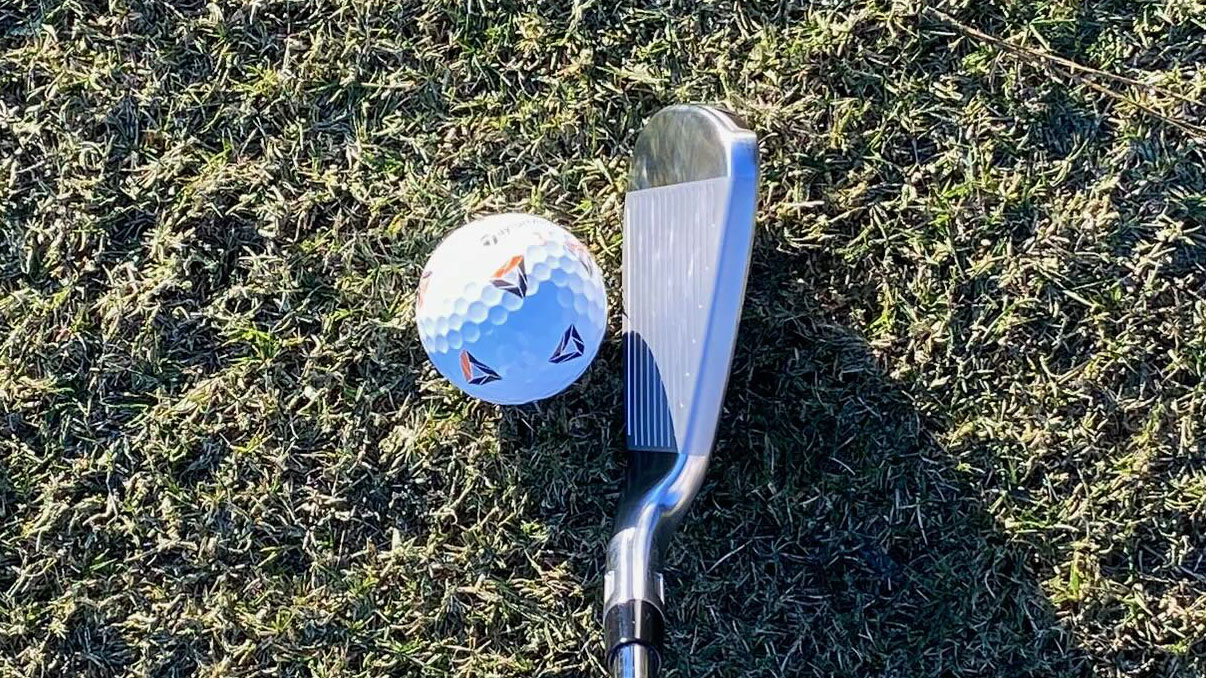Ping G430 vs TaylorMade Qi Irons: Read Our Head-To-Head Verdict
How do two of the best golf irons of 2024 stack up against one another? We tested them side by side to find out

Matt Cradock


The Ping G430 iron adds extra distance to the performance party without compromising forgiveness or consistency. The feel is solid, lively and approach shots just seem easier to execute, which genuinely elevates your enjoyment of the game.
Pros
- Notably longer than G425
- Impressive stopping power
- Very consistent off center
Cons
- Badge appearance will divide opinion

A super powerful and forgiving iron in the game improvement category. On the firmer and clickier end of the spectrum in terms of feel and acoustics, but extremely strong in terms of distance, helped by the subtle draw bias.
Pros
- Exceptional distance
- Very forgiving
- Good launch considering the strong lofts
Cons
- Not a huge change from the Stealth iron visually
- Quite a firm feel at impact
When it comes to the best golf irons on the market, both Ping and TaylorMade are prominent names. Not only do the brands produce some of the best golf drivers money can buy, but their wide range of irons cater to an equally wide range of golfers.
Following their namesake in the driver department, the Ping G430 and TaylorMade Qi sit amongst the best game improvement irons on the market. However, given that these models will appeal to a huge number of players, it's only right that, after extensive testing, we find out what exactly sets these irons apart from one another.
At Golf Monthly, we are huge fans of these clubs and, below, we have drawn up a head-to-head to find out which model is better. From looks to technology and performance, find out which one is best for your game here.
Technology
Beginning with the G430, which Ping billed as being ‘distance competitive, scoring uncompromised’. Compared to its predecessor, the G425, Ping has made a number of enhancements and, technology-wise, we see multiple design changes as well as some alterations in the set make up.
Featuring a combination of lofts that are now slightly stronger, the G430 has a three percent thinner face and a new PUR Flex badge. For those wondering, the PUR Flex badge is made up of 15 pieces that form seven flexible zones so as not to restrict the bending of the face. There are also tungsten toe and shaft tip weights that help increase Moment of Inertia (MOI).

When it comes to the TaylorMade Qi, there isn't much change in terms of visuals from the previous Stealth iron, but the main technological addition comes in the form of 'straight distance'. Essentially, TaylorMade has introduced a patented face technology, individualized in each head throughout the set to control the flexing and reduce cut spin. This is has been identified as a prominent issue for the target demographic in this iron catgeory.
Another innovation is that the Centre of Gravity location in each iron has been tailored depending on the club. In the long irons it is lower to promote an easier launch, whilst the shorter irons see a higher CG to maximize flight control.
Subscribe to the Golf Monthly newsletter to stay up to date with all the latest tour news, equipment news, reviews, head-to-heads and buyer’s guides from our team of experienced experts.

Looks
Straight off the bat, it's safe to say that these irons aren't that different, aesthetically, to their previous models... Both still follow the same design and look, which isn't always a bad thing, especially when you think about how good the Ping G425 and TaylorMade Stealth were visually.
Beginning with the Qi, the only real differences to the naked eye are a slightly bigger badge on the back and a little more chrome. Aside from that, the address still sees a generous blade length, thick top line and plentiful offset that only increase confidence when stood over the ball. Overall, it's an elegant and aspirational look and we can see why not much has changed.
Similarly, the overall shape hasn’t really changed in the G430. The only notable differences are that the head has been made a little more compact, but the grooved area looks a little longer. A few aspects that have remained are the notable offset, generous top line and the iron number inscribed on the face which, in all honesty, we aren't the biggest fans of.
Although you won't see it at address, there is now an extra one degree of bounce on the sole of the Ping G430. This helps lower the CG and also provides more insurance if not struck properly, something which the most forgiving irons are designed to do.
In conclusion, there are differences between the two, such as the more compact head of the G430 and the fact it has the number inscribed on the face, however, both follow a similar path to their predecessors. As a result, it's the Qi which just takes the edge here, due to the slightly more traditional and refined aesthetic.


Feel
The Ping G430 is slightly noisier at impact but has a lower pitch than its predecessor the G425. Sound was really the only thing you could nit-pick with the G425 irons but this improvement with the G430 shows that Ping are really listening to the feedback. Ping has done a great job of improving the feel of this iron too - it’s much closer to that of a forged iron than we were expecting
The TaylorMade Qi on the other hand felt a little harsh at impact with a clicky and firm feel off the face. Whilst you don’t expect the soft impact of a forged blade like the Mizuno Pro 221, the clickiness of the Qi surprised us a little. On a positive, however, the wide sole slid through the turf nicely and felt great in that aspect, with the feel of the strike very consistent across the face.
Overall though, this is the biggest difference we have found so far and the Ping takes this category comfortably.
Performance
While the categories mentioned above are important, really when it comes to choosing an iron the most crucial aspect is performance. If you need to hit every shot out of the middle to achieve a decent result or if you can't get them to stop on the green they aren't going to be much use to you, no matter how nice they look or how much tech is packed into them. So let's see which of these irons comes out on top on the golf course.
Starting with the Qi irons, the speed with which the ball zipped off the club face was the first thing to jump out at us. The ball came off at an almighty velocity which added an incredible amount of distance and, in our review, our tester noted that these went about 10 to 12 yards further than the irons he uses, Callaway Apex CBs.
This increase can be attributed to the lofts these distance irons come in at though, which are much stronger than many of the best irons for low handicappers. Because the lofts are strong, we found that the spin was on the low side which is great for those windy conditions and getting more run out off the tee (the 4 iron went miles!), but it does impact the stopping power of these irons. We found in our testing that even with a decent launch height, stopping these irons would be tougher in firmer conditions.
There is limited workability but the Qi will help those who tend to slice the ball, with there being a slight draw bias that does indeed help straighten up that left-to-right ball flight.

Onto the Ping, and there is a difference in lofts which makes like for like comparisons slightly more difficult. Even allowing for that, we saw some differences in our testing that should be factored in when making your choice of which set is right for you.
The Ping G430 seven-iron has a loft of 29° while the TaylorMade Qi seven-iron comes in at an even stronger 28°. This partly explains why the G430 spins more and gives more control on approach shots that the Qi, which tends to come in hotter and with slightly less spin. This means the Qi will be beneficial to the shorter hitting golfer looking for that extra bit of run, but the golfer who likes to hit nice high approach shots that sit down quickly will be better served by the Ping G430.
The most impressive aspect of this is that Ping have managed to add distance while still providing that launch or height. For context, the ball speed and carry distance data was comparable with our testing of the Cobra Aerojet iron, which is 2.5° stronger in loft. It's forgiving too, misses low on the face got up higher than we expected and you’ll likely carry bunkers you’d expect to find after a thin strike with the G430 irons.
A win for Ping when it comes to head to head performance.
Which One Should You Choose?
Choose the Ping G430 iron if…
- You want to see a higher, more stable ball flight
- You want a forgiving clubhead
- You value control and consistency over workability
Choose the TaylorMade Qi iron if…
- You want to negate a slice
- You want to see a lower ball flight with less spin
- You want a more traditional shape

Joe has worked in the golf industry for nearly 20 years in a variety of roles. After a successful amateur career being involved in England squads at every age group, Joe completed his PGA degree qualification in 2014 as one of the top ten graduates in his training year and subsequently went on to become Head PGA Professional at Ryder Cup venue The Celtic Manor Resort. Equipment has always been a huge passion of Joe’s, and during his time at Celtic Manor, he headed up the National Fitting Centres for both Titleist and Taylormade. He’s excited to bring his knowledge of hardware to Golf Monthly in the form of equipment reviews and buying advice.
Joe lives in North Devon and still plays sporadically on the PGA West region circuit. His best round in recent years came earlier in 2023 where he managed a 9 under par 63 at Trevose GC in a Devon & Cornwall PGA Tournament.
Joe's current What's In The Bag?
Driver: Switch between TaylorMade Qi35 and Callaway Elyte TD - both with Fujikura Ventus Black 6-X
Fairway wood 1: TaylorMade BRNR Copper Mini Driver - Fujikura Ventus Black 7-X
Fairway wood 2: Callaway Apex UW 17˚- Fujikura Ventus Black 9-X
Irons: TaylorMade P7CB 3-PW with Dynamic Gold Tour Issue X100 shafts
Wedges: Callaway Opus 50, 54, and 60 degrees - Project X LS 6.0 shafts
Putter: LAB Golf Oz.1 (zero shaft lean)
Ball: TaylorMade 2024 TP5x
Grips: Golf Pride Tour Velvet 60R
Bag: Vessel Player IV Pro DXR Stand
- Matt CradockStaff Writer